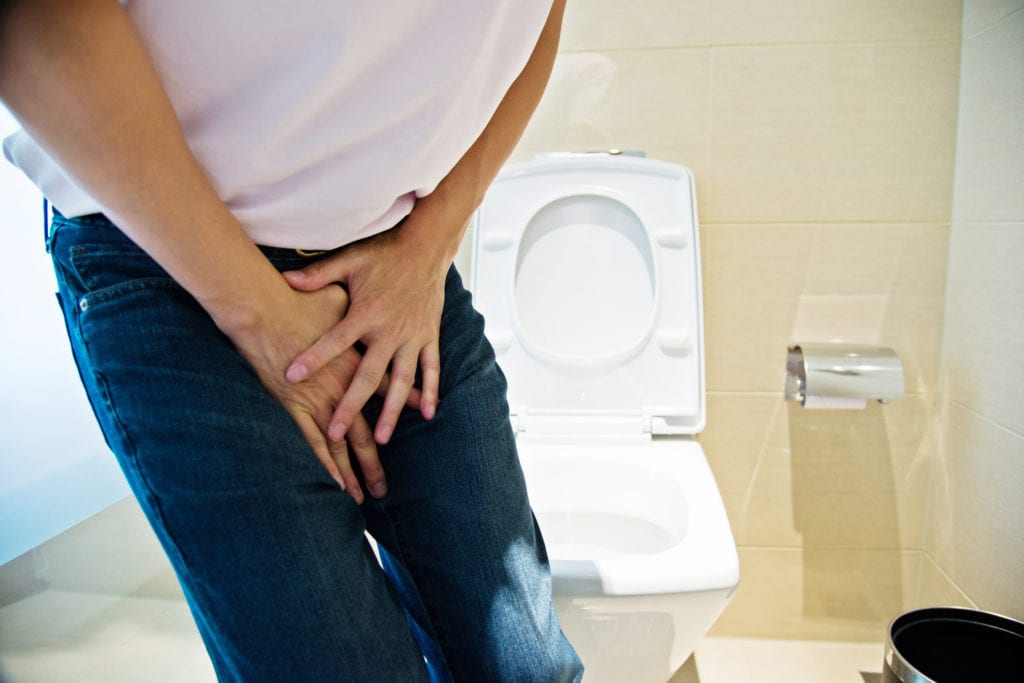Male Urinary Leakage Chattanooga, TN
Male Urinary Incontinence & Post Prostatectomy Incontinence
What Is Urinary Incontinence?
Urinary incontinence is the accidental leakage of urine. This usually causes problems when it occurs at inconvenient times or “all the time” for some.
Urinary leakage can occur with men just like women. The impact leakage has on any individual is significant and may affect social function. Urinary leakage can lead to avoidance of certain activities and situations due to fear of embarrassment. Leakage can also lead to increased spending on diapers and pads that do not treat the cause of the leakage only the symptom of leakage. Dr. Shridharani and his colleagues specialize in the treatment of all causes of male urinary leakage. There are many medical and surgical options available to allow you or your loved one to control urinary leakage and to get you back to enjoying life.
Schedule an Appointment with Dr. Shridharani
Causes Incontinence After Prostate Removal
The bladder and the urethra control urination. When your kidneys produce urine, they empty it into the bladder to hold until urination. The bladder is muscular and shaped like a balloon. When you urinate, the muscles of the bladder wall contract and force urine out of the bladder into the urethra. Muscles that surround the urethra then relax and allow the urine to flow through it and out of the penis.
Because the prostate gland surrounds the urethra, it can cause different issues with urination. If the prostate becomes enlarged, it can obstruct the urethra, inhibiting flow. This is a natural part of male aging, as the prostate becomes larger with age, making urination a slower, longer process.
But when the prostate is either removed or destroyed with radiation, this disrupts the way the bladder holds urine and can lead to urine leakage. Radiation can decrease the bladder’s capacity and cause the bladder to spasm, leading to urine leakage. Surgery can also damage the nerves that are involved in bladder control. If the bladder neck sphincter (the muscle that is normally closed to prevent urine leakage) is damaged during prostate surgery, this can lead to incontinence.
How Common Is Urinary Leakage After Prostate Surgery?
Urinary incontinence is common in men who’ve had prostate surgery/removal or radiation. At six weeks after surgery, almost two-thirds of men can expect to have some degree of incontinence, as defined by using a pad. These numbers drop with time, but after a year around 20 percent of men can still have some degree of incontinence. This tends to be higher in men who are inactive. The numbers keep dropping as bladder function and control are regained. In three years, less than 10 percent of men who’ve had prostate removal surgery are incontinent.
Types Of Urinary Incontinence After Prostate Surgery
There are three different types of incontinence:
- Stress incontinence is the most common type of urine leakage men experience after prostate surgery. Leakage occurs when a person coughs, sneezes, or laughs.
- Urge incontinence is the type that occurs most often after radiation treatment. This incontinence involves the need to urinate frequently with occasional episodes of leakage.
- Overflow incontinence happens when the bladder doesn’t empty as it normally should. Signs of overflow incontinence are taking a long time to urinate, a dribbling stream with little force, getting up often during the night to go to the bathroom, and the feeling that you can’t pass enough urine to feel your bladder is drained.
Click to Call Dr. Shrid Today to Learn More

How Long Does It Take To Recover From Incontinence After Prostate Surgery?
Since the cause is usually tied to damage to the bladder and/or the urethra, particularly the sphincter muscles that control each, complete recovery can take anywhere from six months to 18 months. In patients who had normal continence prior to prostate surgery, the vast majority will regain full function within 12-13 months after surgery.
I Just Underwent Prostate Cancer Surgery And I Leak, What Should I Do Now?
Treatment for urinary leakage related to prostate cancer depends on how long ago your procedure was and how much you are leaking. Typically most people leak urine after the catheter is removed after the prostate removal. The good thing is that most people will regain urinary control over time. Only about 1 in 10 men will have significant leakage that affects lifestyle 1 year after the prostate is removed.
One of the first options to improve urinary control is in the form of pelvic floor exercises (PFE) or Kegel’s. PFE can be performed by tensing the muscle used to start and stop urination. Practice makes perfect and the effectiveness of these exercises is improved when assisted by a pelvic floor physical therapist that can be recommended for you. Pelvic floor exercises may help you regain control of your urinary function earlier after your prostatectomy compared to if you did not do the exercises. Once you are several months to a year out from your procedure the exercises have less benefit so it’s in your best interest to start them early.
What Is Considered Normal For The Number Of Times Per Day A Person Urinates?
This varies dramatically depending on how much the person drinks during the day, but a healthy person may urinate anywhere from 4 to 10 times per day. The average amount is from 6-7 times in a 24-hour period.
I Had My Prostate Procedure Performed 3-9 Months Ago, I Am Still Having Significant Leakage. What Are My Options For Treatment Now?
Within a year from the surgery, it is beneficial to continue to perform PFE because there is no harm to doing them. Your urologist will assess your leakage by pad use, degree of wetness, pad weights over a 24-hour period, and voiding diary. A small camera may be placed into your bladder to assess the sphincter and make sure there is not a blockage in the urethra. Often times you can have more than one type of leakage, especially if you are leaking at night. If you are identified as having urge leakage, medications, and lifestyle changes may resolve your leakage. If the main component of your leakage occurs with cough, sneeze, or activity then there are multiple options.
Therapies are directed at treating the cause of the urinary leakage versus managing the leakage. Pads, diapers, clamps, and condom catheters may be used but do not really affect the volume of leakage. These options are temporary solutions and can be used if you have been experiencing slow improvements in your urinary control or are too unhealthy to try other therapies. The cost of diapers and pads can be significant; moving towards definitive therapy of your leakage may be in your best interest and will be discussed by your urologist.
Medications and procedures can be offered to effectively treat the cause of the leakage. Duloxetine, originally used to treat depression, has been known to help stress urinary leakage. Its use is off-label and has the side effects of nausea, GI upset, and insomnia.
Urethral bulking is a minimally invasive outpatient procedure, which has shown to be effective for stress-related leakage. While asleep a small scope is placed into the bladder and a bulking agent is placed into the sphincter to allow it to close better. This is an option only in select cases of mild urinary leakage 6-12 months after their prostate cancer surgery.
Schedule Your Appointment with Dr. Shrid Today

It Has Been 1 Year Or More Since My Prostate Cancer Procedure And I Am Still Bothered By My Leakage. What Can I Do?
After 1 year of stress urinary leakage, the healing from the prostate surgery is likely done and increases in urinary control without treatment is very unlikely. Surgical management to correct the urinary leakage is the gold standard. The procedural options include the placement of a urinary sphincter or sling placement.
Placement of an artificial urinary sphincter (AUS) is the gold standard for the treatment of stress urinary leakage. This device is very successful at treating all degrees of stress urinary leakage, mild to severe. The AUS is a mechanical implant that has several components including an inflatable ring placed around your urethra that acts as your urinary control mechanism, a pump placed in your scrotum that controls the opening of the ring and a balloon that is placed behind your abdominal wall that holds saltwater to inflate the ring.
All the components are placed within your body and are completely concealed. When you want to urinate the pump is pressed and the inflatable ring deflates allowing urine to freely pass out of your system. Over time the ring reinflates with the saltwater allowing no further leakage to occur when active. The device is usually implanted while you are completely asleep and involves a less than 23-hour hospital stay. Risks of infection of the implant requiring removal, bleeding, erosion, and urinary retention are quite uncommon and can be discussed further by Dr. Shridharani during your consultation.
If you are found to have mild to moderate urinary leakage based on your pad use you may be a candidate for urethral sling placed. The urethral sling is a piece of mesh that acts as a hammock compressing and elevating the urethra back into a more normal position. The advantage of the sling is that there are no moving parts and there is no chance it can fail due to malfunction. The sling is placed through a small 4-5 cm incision between your scrotum and anus. Placement requires placement while you are completely asleep and involves a less than 23-hour hospital stay. Risks of infection, bleeding, erosion, thigh pain and urinary retention are quite uncommon and can be discussed further by Dr. Shridharani during your consultation.
There are two types of slings produced for male urinary incontinence the AMS Advance Sling and the Coloplast Virtue Sling. The Virtue sling differs from the Advance sling because it has four arms instead of two arms. The theorized benefit of Virtue Sling is that it compresses the urethra better and it is placed outside the muscle over the urethra lessening the chance of erosion; however, there has been no head to head trials comparing the two for effectiveness.
What is the Virtue sling?
The Virtue male sling is made of a soft, flexible polypropylene mesh material. Dr. Shridharani</a uses the Virtue sling to treat mild to moderate urinary leakage. It is implanted and it adds support and elevation to the urethra. The Virtue sling utilizes a novel four-arm approach to maximally elevate and compress the bulbar urethra to achieve urinary control.
How does the Virtue sling help with urinary incontinence?
The key to the success of this device is to elevate the urethra. Urethra elevation is essentially realignment, returning it to its pre-prostatectomy position. This is the man’s natural anatomical structure. The sling additionally provides compression of the urethra, which helps provide the resistance necessary to control urine leakage.
How is the Virtue sling placed?
Dr. Shridharani places the Virtue sling during an outpatient procedure. It is a minimally invasive procedure with an incision only a few centimeters in size. After numbing the area, he makes an incision through the perineal tissue (the flat area between the scrotum and the anus). Next, Dr. Shridharani places the four arms of the mesh over the muscle overlying the urethra. This prevents the mesh from growing into the urethra which other mesh products can do. By compressing and elevating the urethra with the surgical mesh it creates a hammock that gently moves the urethra into a new position and increases resistance in this area controlling urine leakage. The procedure usually takes less than one hour.
Watch Dr. Shridharani Place The Virtue Sling
What are the benefits or advantages of the Virtue sling for male urinary incontinence?
This procedure is not major surgery. It requires a small incision in the perineum, and it does not create an involved recovery period. After this surgery, most patients keep a catheter in place for 1, and possibly longer. There will be some initial swelling, and sensation change but this clears quickly. Leakage control should be noticed right after the catheter is removed.
After Dr. Shridharani places the Virtue sling patients are either cured (meaning they no longer need a pad) or markedly improved depending on their initial degree of leakage.
What are the success rates for the Virtue sling?
We have had good success with this device. This is backed up by data from Coloplast, the company that makes the Virtue sling. Coloplast reports that 78 percent of its Virtue sling patients report they are very much or much improved at 6 months after insertion of the sling.
What is the recovery like?
The recovery from this procedure is minimal since the incisions are small. Usually any scrotal swelling will resolve quickly especially with icing. Activity restrictions particularly preventing motions like squatting and high stepping must be followed for 6 weeks. This is important because the sling can become dislodged with particular activities leading to return of leakage. Otherwise minimal lifting, light exercise, and routine activity can be performed until cleared by Dr Shridharani.
Treatment For Urinary Incontinence
Prostate surgical methods are improving with the goal of limiting damage to the sphincter muscles around the urethra. Surgeons try to save as much of the area around the bladder and the urethra sphincter muscles as possible. The process of placing radioactive seeds into the prostate has also advanced to where it is more precise and causes less damage to the bladder.
Still, urinary incontinence is a likely side effect after prostate surgery. Here are some of the treatment methods for addressing it.
- Pelvic floor exercises — Also called Kegel exercises, these exercises target the muscles you squeeze when trying to stop urinating. These can become weakened after surgery, so strengthening them can help limit incontinence.
- Supportive care — These are behavior modifications, such as avoiding caffeine, alcohol, spicy foods, drinking less fluid, and not drinking before bedtime. Changing medications can help, as can weight loss and becoming more active.
- Medication — Various medications can increase bladder capacity and decrease the frequency of urination. Other medications are in the pipeline to specifically target urinary leakage.
- Artificial sphincter — This is a three-part device consisting of a pump, a pressure-regulating balloon, and a cuff that encircles the urethra and prevents urine from leaking.
- Bulbourethral sling — A sling is made from a synthetic material or from the patient’s tissue and is used to create the urethral compression necessary to control the bladder.
- Other surgery, injections, and devices — There are other options, such as surgery to place rubber rings around the tip of the bladder to hold urine, and these keep evolving. Dr. Shridharani can discuss the latest options with you that fit your situation.
Click to Call Dr. Shrid Today to Discuss Treatment Options
What is an artificial urinary sphincter?
An artificial urinary sphincter (AUS) is a three-part device that features a cuff that is placed around the urethra, a pump implanted in the scrotum, and a balloon placed in the pelvic area. The cuff is inflatable, and it is placed around the urethra close to the point where it joins the bladder. The balloon controls the inflation and deflation of the cuff. This prevents urinary leakage. When the person needs to urinate, the man actively deflates the cuff by pressing the small pump. This opens the cuff and allows the patient to urinate. The cuff remains open for about 3 minutes. Over a minute or so, the cuff is again inflated, filling with fluid without having to press it again. Now the patient has continence again.
What are the benefits of using an artificial urinary sphincter for severe urinary incontinence?
This is a very successful device for treating all types of urinary incontinence, mild to sever. It is the gold standard for management of urinary leakage after men have incontinence after prostate surgery. Satisfaction rates after these procedures are over 90 percent. When a person has trouble holding onto their urinae after prostate surgery, it is usually because their sphincter is weak or damaged. By having an AUS placed that mimics the natural sphincter, urinary control is restored. Dr. Shridharani’s patients using this device enjoy much more confidence and freedom.
How is the artificial urinary sphincter placed?
For this surgery, patients receive general anesthesia. Dr. Shridharani typically places the devices through two small incisions. One incision is made in the space between the scrotum and anus, the perineum. This incision is used to place the cuff. The other is made near your lower groin to place the balloon and pump.
What is recovery like after having an artificial urinary sphincter placed?
Patients have a catheter placed to drain urine from their bladder for 1 day. There will also be inflatable boots on your legs to help ensure blood flow and to prevent the formation of blood clots. These will be removed when you leave the hospital, usually the day after your surgery. Scrotal swelling is normal and will resolve over the first 1-3 weeks. Pain can be expected by some if the swelling is pronounced but this does not occur in most patients for a prolonged period of time.
At first, urine will leak from your artificial urinary sphincter. This is normal because the device has not been activated yet. In about 6-8 weeks, after the AUS has healed into place, Dr. Shridharani will activate your device, and you should enjoy good results.
I have undergone radiation after my prostate cancer surgery, does that change my chances of improving my leakage through surgery?
Yes it usually does. The effectiveness of urinary slings to treat urinary leakage after prostate surgery with radiation is around 50%. Artificial urinary sphincters work well in the setting of radiation but your surgeon may have to place the AUS in a different position or perform other maneuvers to minimize the chance of device erosion which is higher after radiation.
What Is The Next Step?
Many men undergo prostate cancer treatments live a different kind of life after treatment due to the side effects of urinary leakage and erectile dysfunction. Unfortunately, many men may suffer alone with the avoidance of social situations and intimacy due to the emotional impact these conditions have. Seeking professional help from urological experts who can manage the complex side effects of prostate cancer surgery may allow you to return to normal function.
Dr. Shridharani’s Men’s Health clinic offers state-of-the-art treatments for persistent urinary leakage and ED after surgery. We provide a comfortable setting where your quality of life issues will be managed at your pace. Our mission is to help you re-engage in social situations and normal activities that may be avoided due to urinary leakage.
Patient Testimonial
“Hey!! All you men out there with urinary and ED problems, if I may take a moment of your time. I am 66 years of age and in fairly good health. As of a year ago I was diagnosed with bladder and prostate cancer. Of course I had to have both removed and that left me with urinary and ED problems. I had to wear diapers and could not have sex for over a year. I thought my life was over. I felt worthless and I had lost control of the bedroom.
Then one day I met Dr. Shridharani and he said that he could help me. Well as of 6 months ago he did! He installed an artificial sphincter and a penile implant. Hey guess what! Now I don’t have to wear diapers anymore and hey man I can have sex again. It is wonderful to be a man again.
Fellows there is help out there. Get off the couch and take back your bedroom. Really “be all you can be” again. Believe me, you and your wife will be glad that you did.
Dr. Shrid gave me my life back and he can do the same for you. Call now and make an appointment to see him today. This will be a decision you will never regret.
Thank you for listening.”
– Gary H.
My experience was very good with Dr. Shridharani. This was my first appointment but he was very kind and he took the time to go over systems and provided a plan to move forward. I would recommend Dr. Shridharani to men looking for a knowledgeable professional that listens to you.
Click here to read more reviews.
Schedule a Consultation Today!
Dr. Shridharani proudly serves Chattanooga TN and Knoxville TN, Northern Georgia, Huntsville AL, and the surrounding areas with advanced treatments for male urinary leakage. Call (423) 778-4MEN (4636) or fill out a Contact Form to schedule an appointment today!





